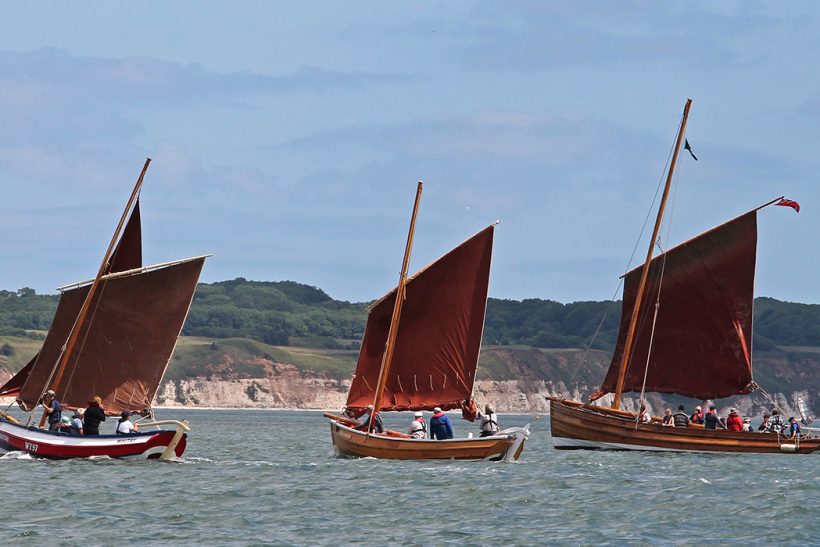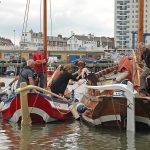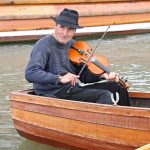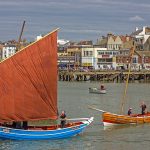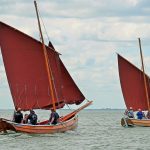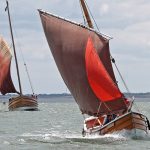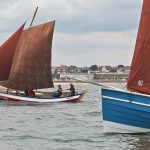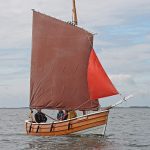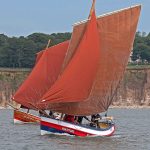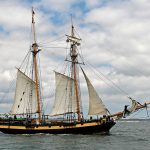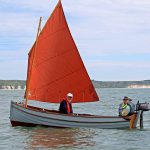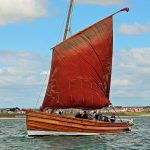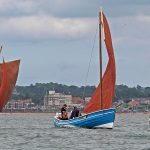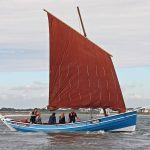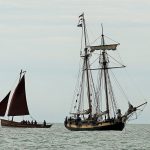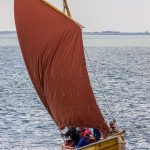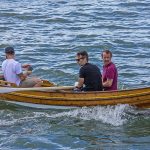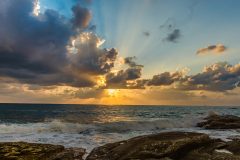Traditional sailing cobles make good use of improving weather conditions for the second Bridlington Sailing Coble Festival, reports Paul L Arro.
Above: The cobles Gratitude, Free Spirit and Three Brothers make a fine sight sailing well off Bridlington.
The month of June was always looked on as the start of summer, with the longest day quickly followed by Midsummer’s Day, and thoughts of long, dry periods of settled weather and sweltering heat. Sadly this year, the last week in June proved to be anything but.
Certainly, the northeast coast of England, in particular – in fact, the whole of Britain – was battening down the hatches to prepare for a low that would sit firmly over the country for much of that week. The weather forecasters were correct and heavy rain, together with near gale-force winds, lashed Britain, and the North Sea coast of East Yorkshire did not escape, with severe weather alerts and flooding predicted for Bridlington.
Members of the organising committee of the second Bridlington ‘Sailing Coble Festival’, set for the weekend of the 1-2 July, had their fingers crossed and were seeking out every piece of wood to touch in the hope the meteorologists were correct in their predictions that the coming weekend would be ‘more like summer’. As with any event, planning had started early in the year and to have the festival cancelled due to bad weather was just unthinkable.
The morning of Saturday 1 July looked promising, however, although light grey cloud covered the bay, the sun was trying its very best to break through and the sea was slight, with just an air of a westerly breeze. Coble crews began to muster around 9am down at the Harbour Heritage Museum and the vessels prepared for sailing. With high water at 11am there was not too much time for chit-chat, although it was obvious from comments exchanged between the skippers there was a slight sense of good-hearted rivalry – most had taken part in the first ever Sailing Coble Festival the previous year.
Very soon Gratitude was making her way from her mooring and heading through the piers to the open sea, quickly followed by the rest of the flotilla; Madeleine Isabella, Bethany of Bridlington, Rose, Imperialist, Three Brothers, Free Spirit, and the motor coble Harlequin; a course being set south, taking advantage of that westerly breeze.
Anchored in Bridlington Bay was HMS Pickle, a two-masted topsail schooner, which is an exact replica of the vessel that was part of the British fleet at the Battle of Trafalgar in 1805. In fact, the vessel selected by Collingwood to bring back to Britain the news of the victory and also the death of Nelson; she was the fastest vessel in the British fleet. The sight of seven traditional northeast coast working boats under sail going round HMS Pickle was indeed a grand sight, reflecting a scene from a bygone era when it would have been commonplace for a sailing ship to be awaiting the tide to discharge her cargo at Bridlington, and local fishermen perhaps competing to get some work from its Master.
Very soon the sailing cobles were off Hamilton Hill, south of the port, and it was time to go about and head on a northerly tack towards the North Bay and the harbour’s North Pier, which was a vantage point for visitors, many having made a special journey to Bridlington just to glimpse this unique festival.
By this time, the sun had broken through and Bridlington Bay looked at its very best with the stunning white cliffs of Flamborough Head affording a splendid backdrop. Just off the harbour was Jack’s, a beautiful 16-foot rowing skiff, the last boat to be built by Jack Siddall of the local Siddall boat-building firm. Jack had died just after the skiff had been completed and it was named after him by his sisters.
Once back in the harbour, and a very welcome coffee for some, chatter among the crews was about the morning’s sail and how these beautiful vessels had performed. No problems had been encountered and no masts had been displaced, as was the case last year. The eagerness and anticipation to get back out for a further exhilarating sail was obvious.
The Harbour Heritage Museum, run by the Bridlington Sailing Coble Preservation Society, had a constant flow of visitors and the locally, well known musician Jim Eldon (the ‘Brid Fiddler’) kept people entertained with his sea songs and shanties, some being performed from a cog boat as he was rowed up and down past the now moored sailing cobles. A couple of stands had been put up this year on the harbourside, one to promote the local coble society and the other by two local authors.
Time was now pressing on and with the crews conscious of the ebbing tide, moorings were slipped and a further parade of sails out of the harbour took place. While keeping clear of the local ‘pirate ship’, pleasure steamer Yorkshire Belle and the passenger-carrying speedboats, the sailing cobles encountered cannon fire from HMS Pickle which, with her sails set, had moved from her overnight anchorage to ‘attack’ the harbour.
A spectacular scene was encountered, with the cobles looking quite small against this 73-foot, twin-masted vessel. The sailing cobles headed south once again and were soon off Ulrome with that westerly breeze.
The dipping lugs were lowered, the cobles went about, the spar and sail moved around the mast and the tack was altered in readiness for the run home. What a splendid sight it made as the six sailing cobles, along with the Tyne work-boat Rose, seemingly took no time at all to see the harbour entrance present itself before them. Safely moored by 3pm, and with the dulcet tones of the ‘Brid Fiddler’ still drifting across the water, the crews stowed their gear and made tracks for a well-earned rest and a cool beer.
Sunday dawned a beautiful day, a clear blue sky with not even a whisper of a cloud but still that westerly breeze, if anything slightly fresher than the previous day. Activity down on the harbourside began around 10am when crews arrived to ready the cobles for sailing.
All the cobles passed through the piers and headed in a southerly direction accompanied by the safety boat Gannet and the motor coble Harlequin, which also carried a film crew as well as photographers. The vessels were soon almost out of view from the harbour and well south, but some great shots of the group had been achieved before going about and making back.
What a wonderful sight those cobles made under full sail and in near perfect conditions, certainly a sight to behold. Once back and moored alongside Harbour Road, the skippers gathered to be presented with brass plaques by Chris Wright, the chairman of the Bridlington Harbour Commissioners, to commemorate this year’s festival.
Formalities over, and with an ebbing tide to contend with, there was just time for one final sail before it was time to stow equipment and conclude the activities of another very successful Sailing Coble Festival. The conclusion to what had been a fantastic weekend was a flypast by a Spitfire from the Battle of Britain Memorial Flight, piloted by Flt Lt Andy Preece, which flew three passes over the harbour at low altitude giving everyone chance to see the D-Day stripes that adorned this iconic fighter. On the final pass, Andy dipped the Spitfire’s wings in a touching tribute before he flew off into the clouds.
All that remained was to moor the cobles, gather together equipment and gear, and bid farewell to the many friends, coblemen and enthusiasts who had travelled from North Yorkshire and Northumberland to soak-up the atmosphere at what is fast becoming the ‘sailing coble capital’ of the British Isles. Yes, there is already talk of another next year… I think that goes without saying really!
Read more from Fishing News here.



